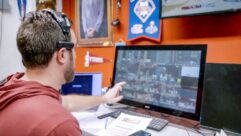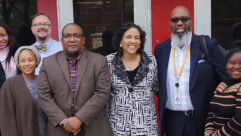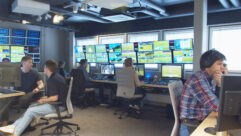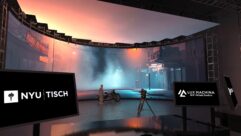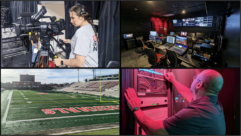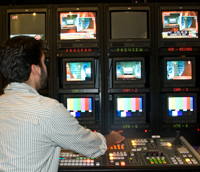

Boston University College of Communication Wired for Production
Jul 16, 2009 3:09 PM,
By Linda Seid Frembes
Boston University College of Communication chose to upgrade its Echolab Opera
switcher, purchased last year, to an Overture 1 switcher using a software upgrade from the company. The switcher fit the budget and capability requirements. The new Overture 2 switcher is located in Studio West.
Higher-education facilities have the challenge of balancing the need for cutting-edge production technology and limited budgets. Even high-profile schools such as Boston University College of Communication (COM) must compare features versus benefits in all studio equipment—from studio and field cameras to digital editing workstations to digital switchers—and purchase the equipment that gives their students the best hands-on experience without busting the annual budget.
COM has produced many notable talents over the years, including cable-television host Bill O’Reilly, Comcast Entertainment CEO Ted Harbert, and SciFi channel President Bonnie Hammer. In the school’s film and television program, students get with all aspects of television production.
During the school year, the studios are in use from 9 a.m. to 9 p.m. with very little downtime. The bustle is due to regular class loads as well as the use of the studios by professor-supervised student groups such as Growling Dog Productions that produces student-run programs such as the soap opera Bay State and several news-magazine-format shows. The Boston campus has its own cable network (called TerrierVision) with a cable head located on the main campus grounds where these programs are shown. Students are free to produce the shows as they wish using the studios and editing suites. There are several dedicated student channels on the station.
A small video server in the COM building drives all the TerrierVision channels. Students shoot footage and compress it to MPEG-2 format, load the files onto the Firefly computer, which feeds the signal across the fiber channel to then cable head. “We are driving two channels [BUTV6 and BUTV10]: one channel with cable cards that change advertisements every few seconds and using student radio as the background, and a second channel showing student productions,” says Matthew Willson, COM’s senior media technician, who repairs and installs the equipment, provides general technical support for classes, and shows the students how to use the technology.
The COM building sits in the heart of Boston University’s campus in Boston, where students have access to two production studios (Studios West and East) and 18 non-linear editing stations featuring both Apple Final Cut Pro and Avid, and five cuts-only stations using Sony DSR1500 DV decks with a controller. Editing capabilities include digital stations using Apple G5 CPUs running a mix of Avid Xpress Pro and Final Cut Pro 4 and Adobe After Effects and Photoshop. According to the school, each digital suite has a DVCAM/DVSP FireWire deck for tape output as well as DVD recorders with Roxio Toast software for optical masters. The audio lab has four digidesign Pro Tools stations, each with the capability to output to either CD or MD.
“We try to pick technology that can advance the capability of the school, but we also keep in mind that some people want to be writers but are required to take technical course,” Willson says.
The building itself has gone through modifications such as power and network upgrades. Previous students who remember Studios A and B would now find those rooms combined into Studio West and editing suites. Studio East, used primarily for video production, was added as part of a previous upgrade. “East is used for any type of TV, like for filming TV commercials and talk shows. It is basically a large empty room with a prop room at one end,” Willson says. “West has a permanent anchor desk, teleprompters, and an interview set where journalism students can practice straight news and sports casts. They don’t get as much into the studio craft except to operate the cameras.”
1
Boston University College of Communication Wired for Production
Jul 16, 2009 3:09 PM,
By Linda Seid Frembes

Both studios’ cameras at Boston University College of Communication are Sony DXC35 standard-definition cameras with analog signal to a bank of monitors. Future plans do include a move to high-def and to multiplexed LCD or plasma displays for monitoring. The school does have several Panasonic AG-HVX200 handheld HD camcorders for field use and some HD editing monitors.
Equipment upgrades are planned based on annual budgets. New switchers and a network upgrade for the department were the big ticket items for this year. “In our general budget range, there are not a lot of options in multidef switchers that bridge SDI and analog, as well as HD and standard,” says Willson, who works with COM’s head engineer Carlo Durante to find the appropriate equipment.
The school chose to upgrade its Echolab Opera
switcher, purchased last year, to an Overture 1 switcher using a software upgrade from the company. The switcher fit the budget and capability requirements. Students using the newly upgraded switcher were pleased by the number of layers that were possible.
The new Overture 2 switcher is located in Studio West. It was chosen as a precursor to a transition to hi-def cameras “because the switchers can be upgraded with a change of a couple of boards, and it is cheaper than buying a whole new switcher,” says Willson, who notes that the Overture 2 replaced a much older Echolab eStudio 2700.
The Echolab switchers bring several new capabilities to student productions. In addition to four M/E keys and two downstream keyers—which enable title keying for graphics, logos, and bugs—the Overture’s Stinger and SuperSource keys that make it easy for the students to achieve expert transitions with minimal effort. The Stinger transition is a “take block” keyer with combined mix/wipe and graphic control that reduces complex animated transitions to a single button. The Overture switchers’ SuperSource allows the user to build a custom layout using DVEs and graphics and then assigns the composition to a crosspoint button. A DVE key in each take block enables instant transition effects.
“The Echolab switchers looked and behaved like a broadcast switcher, something students will likely run into in another studio,” Willson says. “The whole point of our school is to have the students work like they are in a broadcast environment with an entire crew working as a single unit. Therefore, it is important that students get exposure to each kind if equipment.”
An upgrade to the Ethernet network from 100Mbps to 1Gbps means a reduction in the amount of “sneakernet”, also known as students running back and forth with tapes in hand. Willson says they would like to reduce the number of miniDVs in use due to the constant wear and tear on the tapes. “Even professionals beat on their equipment, but we are teaching the students how to be a little less ham-fisted,” Willson says.
While the new network is not fast enough to have a video server hold every student’s material, they can edit on the computer and can swap common files to whatever editing station they are using. “When students are editing a package for class, instead of people running down the hall with tapes and handing to the tape operators, they can dump files across the network to a server, and somebody in the tape room can stack them in a playlist and run them from there,” Willson says. “The software works like iTunes in that you can drag and drop the content into a playlist and reorder it as necessary.”
The school’s first playlist software playback unit is still in use. Willson says that a couple of retired Mac computers were loaded with BitPlayer
, a freeware application from Tanjero that can handle any format compatible with Apple QuickTime. They chose BitPlayer because it was free and easy to use and students can mark in and out points to trim the fat on their files.
With the impending server upgrade and current network upgrade, the studio is investing in professional software called “On the Air” that has similar functions, but it will interface with professional cards and can play fully interlaced high-def video. The school looked at Grass Valley’s Turbo iDDR digital disk recorder as a replacement option, but the On the Air solution was more budget-friendly. “With a software solution, you can run it on any old computer and, in the event of a system failure, you can be back up and running in an hour,” Willson says. “Working with novices means keeping it as simple as possible because the orientation of the school is the humanities angle and not necessarily the technical stuff.”
2
Boston University College of Communication Wired for Production
Jul 16, 2009 3:09 PM,
By Linda Seid Frembes
Willson and his team also added new Sony Handycam DCR-VX2100 digital camcorders to replace older cameras but also to increase the number of field cameras available to journalism students. Production students also have access to Sony DSRPD150
and DSRPD170 DV cameras. “We are teaching the basic skills,” Willson says. “If we were a professional postproduction house, then we would be more worried about the bleeding edge.”
Both studios also recently received upgrades to the newest Chyron graphics systems running the Lyric software. Both studios’ cameras are Sony DXC35 standard-definition cameras with analog signal to a bank of monitors. Future plans do include a move to high-def and to multiplexed LCD or plasma displays for monitoring. The school does have several Panasonic AG-HVX200 handheld HD camcorders for field use and some HD editing monitors.
“We are currently running standard-definition, but if the classes want to use anamorphic widescreen 16×9 for broadcast or DVD, they can flip a switch and it works,” Willson says.
The Firefly willbe replaced with a more sophisticated Princeton video server. “Firefly is designed more for advertising signage than TV use,” Willson says. “It will be part of an equipment upgrade to a more professional type of server.”
COM currently hosts high school students who are attending a summer camp billed as a “complete media production experience.” Like their higher education brethren, the students will learn hands-on production skills such as directing a multicamera, live-to-tape program.
3


